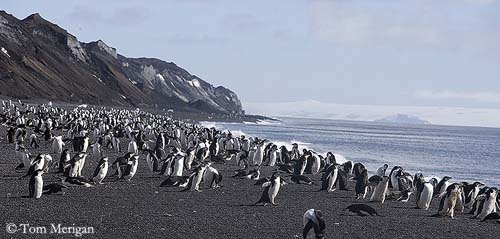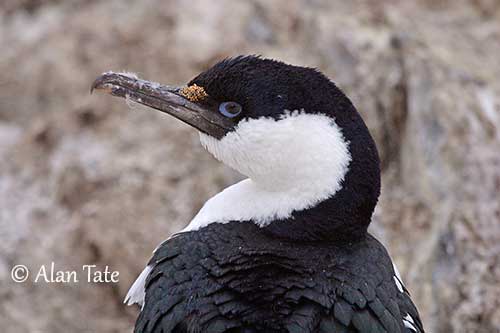


Alan & Ann Tate
AA Bird Photography
SOUTH SHETLAND ISLANDS BIRD SPECIES
The South Shetland Islands are a sting of islands lying at 960 kilometres S to Tierra del Fuego, and about 160 kilometres N of Antarctic Peninsula from which it is separated by the Bransfield Strait. This group of islands consists of 11 major islands and several minor ones, over 3,687 square kilometres of land area.
These islands are mainly covered with ice, with only 2-3% ice-free areas along the coast where the wildlife is found, with in addition human inhabitants in several bases. The climate is cloudy and humid all year round, with strong winds.
The South Shetland Islands includes several islands.
King George Island is the largest and is home of twelve bases of different countries. This low, flat island with broken coastline, shelters several bird species such as Antarctic Tern, Chinstrap Penguin, Adelie Penguin, blue-eyed shags and Southern Giant Petrel.
Elephant Island, which name comes from the shape of the island, is fairly small (60 x 40 km). There, we can find colonies of Chinstrap Penguin. Sea and weather conditions are difficult.
Deception Island is a collapsed volcanic cone (still active) protected by high cliffs and a narrow entrance forming a wide amphitheatre of 12 kilometres wide. The last eruption occurred in 1991-1992. The landscape consists of dark volcanic sand and rocks, but large numbers of penguins nest on this strange island.
Livingstone Island is home to the greatest concentration of historical sites in Antarctica. The wildlife includes large colonies of Chinstrap Penguins and Gentoo Penguins, blue-eyed shags, skuas, Wilson’s Storm Petrels and seals. The highest point of the islands is here, at 2,400 metres of elevation.
Penguin Island is a small volcanic island regularly visited by Chinstrap Penguin, Adelie Penguins, Southern Giant Petrel, Antarctic Terns, skuas, Kelp Gulls and fur seals.
Bridgeman Island is almost circular. This volcanic island rises to 240 metres and is a remnant of a large volcano.
Aitcho Island shelters Gentoo Penguin and Chinstrap Penguin colonies. It is covered by large beds of moss and lichen.
Greenwich Island, formerly Hospital Cove, is a protected positon allowing anchorage.
Half-moon Island is a crescent-shaped island, giving it the name. With only 2 kilometres long, this place has colonies of Chinstrap Penguins and nesting Antarctic Terns and Kelp Gulls.
The South Shetland Islands support vegetation, in spite of harsh conditions. They lie in the cold seas below the Antarctic Convergence. The vegetation is that of tundra and includes mosses, lichens and algae. The surrounding waters provide food to seabirds, penguins and seals.
The South Shetland Islands are one of the most visited areas in Antarctica, as they are home to a great biological diversity.
Text by Nicole Bouglouan
Sources of the text:
Species list :
Sources: Avibase (Lepage Denis)
Adelie Penguin - Pygoscelis adeliae - Manchot d’Adélie
Antarctic Petrel - Thalassoica Antarctica - Pétrel antarctique
Antarctic Prion - Pachyptila desolata - Prion de la Désolation
Antarctic Shag - Leucocarbo bransfieldensis - Cormoran antarctique
Black-bellied Storm-Petrel - Fregetta tropica - Océanite à ventre noir
Black-browed Albatross - Thalassarche melanophris - Albatros à sourcils noirs
Blue Petrel - Halobaena caerulea - Prion bleu
Brown Skua – Stercorarius antarcticus - Labbe antarctique
Cape Petrel - Daption capense - Damier du Cap
Chinstrap Penguin - Pygoscelis antarctica - Manchot à jugulaire
Emperor Penguin - Aptenodytes forsteri - Manchot empereur
Gentoo Penguin - Pygoscelis papua - Manchot papou
Grey-headed Albatross – Thalassarche chrysostoma – Albatros à tête grise
Kelp Gull - Larus dominicanus – Goéland dominicain
Kerguelen Petrel - Aphrodroma brevirostris - Pétrel des Kerguelen
King Penguin - Aptenodytes patagonicus - Manchot Royal
Light-mantled Albatross - Phoebetria palpebrata - Albatros fuligineux
Macaroni Penguin – Eudyptes chrysolophus – Gorfou doré
Magellanic Penguin - Spheniscus magellanicus - Manchot de Magellan
Northern Giant-Petrel – Macronectes halli – Pétrel de Hall
Slender-billed Prion or Thin-billed Prion - Pachyptila belcheri - Prion de Belcher
Snow Petrel - Pagodroma nivea - Pétrel des neiges
Snowy Sheathbill - Chionis alba - Chionis blanc
Southern Fulmar - Fulmarus glacialoides - Fulmar argenté
Southern Giant Petrel - Macronectes giganteus - Pétrel géant
Southern Rockhopper Penguin - Eudyptes chrysocome - Gorfou sauteur
Southern Royal Albatross - Diomedea epomophora - Albatros royal (du Sud)
South Polar Skua - Stercorarius maccormicki - Labbe de Mc Cormick
Wandering Albatross - Diomedea exulans - Albatros hurleur
White-crested Elaenia - Elaenia albiceps - Elénie à cimier blanc
White-headed Petrel – Pterodroma lessonii – Pétrel de Lesson
Wilson’s Storm-Petrel - Oceanites oceanicus - Océanite de Wilson
Tom Merigan
Tom Merigan’s Photo Galleries